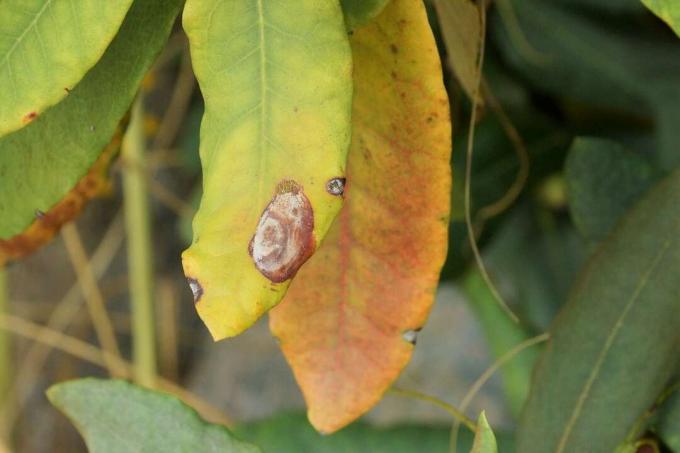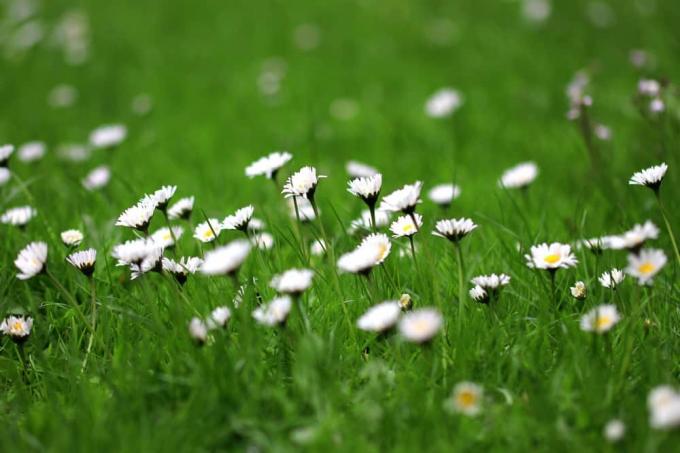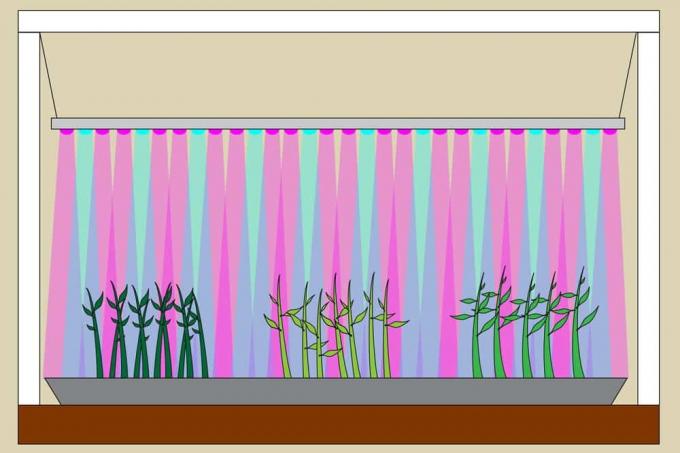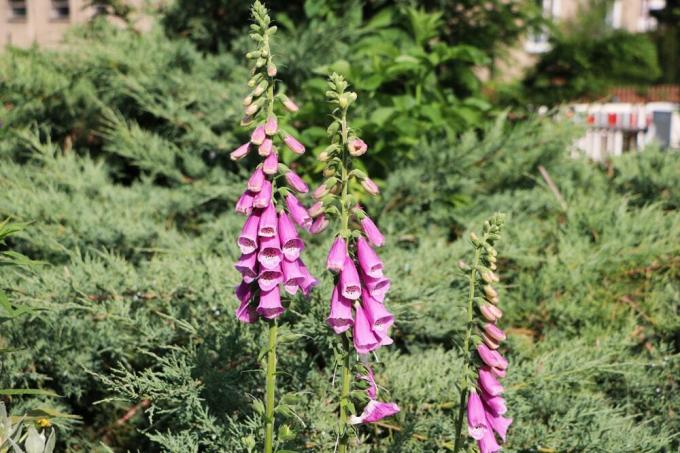

Table of contents
- Location
- Pour
- Damage caused by the plant substrate
- Too cool temperatures
- Brown leaves on palm trees
- Examine damage images carefully
- Frequently Asked Questions
Even with the best care of indoor plants, it can happen that green or flowering plants suddenly turn yellow or brown leaves. Pests can be ruled out in most cases. Rather, a wrong location, too much or too little moisture or incorrect humidity can be to blame for the symptoms. Other causes can lie in the substrate or come to light through the wrong fertilizer. In order to save the plant, hobby gardeners should find out quickly and comprehensively about the ideal growth conditions for their protégés. The plants can be saved by quickly recognizing care mistakes.
Location
If the leaves are turning yellow, too much or too little light can be to blame. If you love a shady location but are in full sun, you will get yellow leaves that later turn brown at the edges and then fall off. The damage is caused by overheating of the leaf tissue. Due to the heat and dry air, brown leaf tips can appear at the same time, the browning of which progresses the longer the plant is in the unsuitable location. First aid measures can be shadowing or a change of location.
Pour
Too little water can cause houseplant leaves to turn yellow, while too much water will result in brown leaves. Depending on the color of the leaves, the plant receives too many or too few nutrients.
Tip:
If there is a lack of water, immerse the plant in a bowl or bucket of lukewarm water until the root ball is saturated again.
If the plant is too moist, you should stop watering immediately and, if necessary, repot the plant from the moist substrate to a dry substrate with plenty of drainage. You need to remove the rotten roots. If plants are watered with hard water, chlorosis can develop. Citrus plants are particularly sensitive to this. Possible damage and possible remedies:
- the leaves turn yellow, the leaf veins remain green - general lack of nutrients: can be eliminated by giving fast-acting complete fertilizer
- first older leaves turn yellow from the tip, later younger leaves too – lack of nitrogen: apply nitrogen fertilizer quickly
- the leaves turn yellow, including the leaf veins - waterlogging: replace the substrate immediately
- young leaves turn yellow overall - iron deficiency: give special iron fertilizer, place plant in acidic substrate
- large yellow spots on the leaves of plants with soft leaves - irrigation water that is too cold: water the plants with lukewarm water and do not wet the leaves
- Older leaves turn yellow at the edges, the center of the leaf remains green - Magnesium deficiency: apply fertilizer containing magnesium, replace substrate if necessary
Tip:
Yellowing of the leaves is common in angel's trumpets when there is a lack of nitrogen. Camellias, on the other hand, turn yellow when watered with hard water.
Damage caused by the plant substrate
If the potting soil is not replaced for a long time, the substrate will be enriched with salt through watering. Over time, these crystallize and form a white coating on the edges of the pot, which can even penetrate to the outside of clay pots. The salts are also deposited on the roots. The plant receives fewer nutrients. This causes the leaves to become limp and brown and eventually curl up and later fall off. The plant dies. In the early stages, replacing the plant substrate helps. If the same flower pot is used again, it should be cleaned thoroughly with a brush to remove the white deposits.
Too cool temperatures
Some houseplants need a very specific temperature threshold to thrive. If this is undercut, then leaf discoloration and leaf fall appear. Ray's macaw, Dieffenbachia and the poinsettia will turn yellow and later drop their leaves. This damage cannot be undone. Yellow leaves can also be caused by drafts, which cause indoor plants to “cold feet”. Insulating styrofoam plates as coasters can help. If the substrate is also rotting, it can help to replace the substrate and remove rotting roots.
Tip:
With tropical plants, the temperature threshold can be as high as +15 °C!
Brown leaves on palm trees
In order to determine the cause of the browning, you need to examine your care habits, because brown leaves on palm trees can have different causes. They are caused by too much water, too little water or over-fertilization. You can cut off dead fronds immediately. Now check the substrate. If it is too dry, give your palm plenty of lukewarm water. The limp leaves that are still green should recover after a while. If there is too much irrigation water, it helps to unpot the palm tree and look at the roots. Roots that are already rotting are removed and the palm tree is potted in new substrate.
Tip:
Do not water the palm for a few weeks!
If a lack of nutrients is the reason for the yellow or brown discoloration, then the administration of fertilizer tailored to palm trees will help. Brown leaf tips on palm trees, on the other hand, indicate a lack of humidity. Here it helps to spray the exotic plants more often. Succulents, on the other hand, get brown leaves from too much watering.
Examine damage images carefully
Take a close look at your ailing houseplants. If harmful insects show up, then affected parts of the plant are removed, the plant is rinsed off or the pot is immersed in a bucket of water so that the pests drown. Fungicides from specialist plant shops help against fungal infestation, which can be recognized by round brown spots on the leaves. If the infestation is very severe, the plant must be disposed of. For gray mold that causes the leaves to turn brown and have a dusty gray coating all over pulls the leaves, it helps to remove the affected parts quickly and to keep the plant airy and light place. Gray mold can be avoided if the plant is given a suitable location and withered and faded leaves are removed immediately.
Frequently Asked Questions
The leaves turn yellow and the buds fall off, the plant covers a fine web.
Foliar polish works surprisingly well against thrips. However, they cannot be used on ferns or soft hairy leaves.
It is best to replace the substrate.
Interesting facts about discolored leaves on plants
indoor plants
- Yellow leaves can have a variety of causes. Overwatering, lack of nitrogen, a location that is too dark, warm or too cool are all part of it. Then the only thing that helps is to limit the watering, to fertilize and to improve the location.
- Brown leaf edges are usually caused by incorrect watering, regardless of whether too much or too little is poured. The soil can also be used up, the air too dry or you have over-fertilized. The care mistakes must be corrected immediately.
- Brown leaf tips are usually an indication that the air is too dry or that the ball is dry. You simply ensure a higher humidity and water vigorously. However, excess water must be removed, because waterlogging is not good either.
- Brown leaf spots indicate a fungus, usually the leaf spot fungus. They can be recognized by the partly bordered spore deposits. The cause is an infection. Diseased plant parts are to be removed. Selected fungicides can be used if necessary.
- Rust-colored heaps of dust on the underside of the leaf and light spots on the upper side indicate the rust fungus. The fungi are often introduced. Here, too, infested leaves must be removed and fungicides used if necessary.
pot plants
- Container plants often get brown leaves during the winter. But that's mostly normal. During the hibernation, watering is sparing and there are no nutrients. Not all leaves survive this. In the spring, when watering and fertilizing is resumed, this should subside.
- If leaves otherwise develop brown edges or turn completely brown, this is usually due to too much or too little water. Potted plants have to be watered frequently in summer because the roots cannot store much water in pots that are often too small. In addition, the air is too dry for many potted plants in summer and they need sufficiently high humidity.
- Yellow leaves are usually due to a lack of nitrogen. This should be fertilized in a targeted manner.
- Otherwise, fungal infections can lead to brown leaf spots. The affected parts of the plant must be removed. A fungicide must usually be used to stop the disease from spreading.
garden plants
- Especially after a new planting, many garden plants tend to yellow and brown leaves. It mostly comes from stress. They have been dug up, have a new location and new growing conditions. As soon as the plants have settled in, this will happen.
- However, stress often leads to fungal infestation. Even then, the leaves turn brown or brown. have brown leaf spots. Affected leaves are removed. Often chemical agents have to be used to eradicate the fungus.
- Frost also causes brown leaves. This can always be seen particularly clearly with the cherry laurel.
- Yellow leaves in garden plants are often due to a lack of nitrogen. Targeted fertilization can help.
- Fungi can also cause yellow leaves, such as Monilia laxa. However, yellow leaves are often due to drought damage after replanting.
 garden editorial
garden editorial I write about everything that interests me in my garden.
Learn more about grooming

send plants | 7 tips for sending flowers
Sending plants requires good preparation. Not only the type of packaging is of great importance, so that the goods arrive safely at their destination. The season is also important. It depends on how well the plants survive the transport.

30 office plants for a better indoor climate
A bit of green in the office not only looks pretty, but can also significantly improve the indoor climate. For example, indoor plants increase humidity, can clean the air and, if they are large enough, even dampen noise.

21 edible flowers | What flowers can you eat?
Edible flowers can be used for many dishes in the kitchen, not just as decoration. The flavors range from sugary-sweet to peppery-spicy and give food and drinks a very special touch.

Everything about LED plant lights: Build plant lights yourself
Plants need light. In the absence of it, they suffer or perish. Sometimes, conventional daylight just isn't enough to meet a plant's light needs. Then LED plant lighting can help. How to build such a plant light yourself is here.

Shade plants: 17 green and flowering plants for the shade
Shady garden areas are a challenge for every hobby gardener, although shade does not mean that it is completely dark. Partial shadow and light shadow are also a type of shadow. The range of suitable plants is growing steadily and offers a variety of design options.

Forest flowers: 55 flowering species in the forest sorted by color
When the local forests dress in picturesque shades of color throughout the year, the numerous forest flowers in Germany present themselves and inspire with their blaze of colour. From purple to red to white and yellow, the German forests have a lot to offer.
